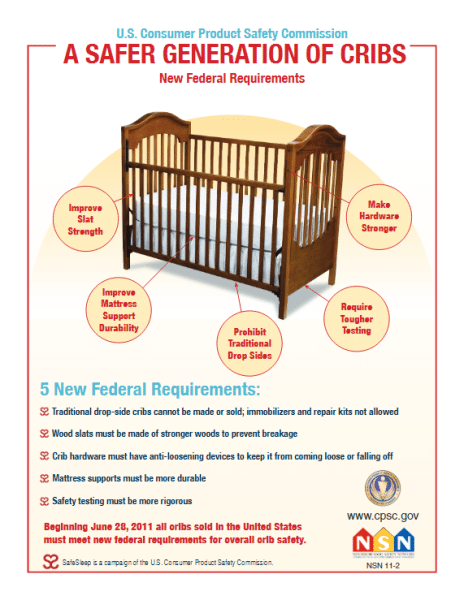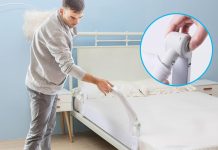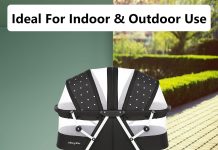Crib safety is a topic that every parent needs to consider, and when it comes to older cribs, it’s essential to take a closer look. In this article, we explore the question on many parents’ minds: are 30 year old cribs safe? With changing safety standards over the years, it’s important to understand the potential risks and precautions involved in using cribs that have been handed down or purchased from previous generations. So, before you make any decisions about your baby’s sleeping environment, let’s dive into the world of crib safety for these vintage pieces.
This image is property of health.clevelandclinic.org.
Review contents
Safety Standards for Cribs
Current safety standards for cribs
When it comes to the safety of our little ones, it is essential to stay informed about the current safety standards for cribs. The safety regulations for cribs have evolved significantly over the years to address potential hazards and ensure the well-being of babies and toddlers. The current safety standards focus on various aspects, including spacing between slats, crib design, mattress fit, and the use of safe materials.
Changes in safety standards over the years
The safety standards for cribs have undergone substantial changes over the years, reflecting a growing understanding of potential hazards and advancements in technology. One of the most significant changes was the ban on the production and sale of drop-side cribs in 2011. This change was in response to numerous reports of injuries and fatalities caused by drop-side crib malfunctions. Additionally, safety standards now require more stringent testing and quality control measures to ensure the durability and safety of cribs.
Key safety features in modern cribs
Modern cribs are designed with a strong emphasis on safety features that minimize potential hazards. Some of the key safety features to look for when purchasing a crib include slats that are spaced no more than 2 3/8 inches apart, ensuring that a baby’s head cannot become stuck. Additionally, cribs should have stationary sides, eliminating the risk of a drop-side malfunction. It is also important to ensure that the crib’s mattress fits snugly, with no gaps that could pose a suffocation risk. Finally, choosing cribs made with non-toxic materials and finishes is crucial to minimize any potential harm to your baby.
Age-related Safety Concerns
Potential hazards in older cribs
While many older cribs were once considered safe, it is essential to be aware of potential hazards associated with them. Older cribs might not meet the current safety standards, as regulations have evolved over time to address new safety concerns. Some potential hazards in older cribs include wider slat spacing, drop-side mechanisms that might be prone to failure, and general wear and tear that could compromise the overall structural integrity of the crib.
Durability of materials in older cribs
The durability of materials used in older cribs could also be a concern. Over time, certain materials may weaken, leading to an increased risk of accidents or structural failures. It is crucial to carefully inspect the crib’s materials, such as the wood, joints, and hardware, to ensure they are still in good condition and capable of providing a safe and secure sleeping environment for your little one.
Evaluating the crib’s condition
When considering using an older crib, it is crucial to thoroughly evaluate its condition. Pay close attention to the crib’s structure, examining for any cracks, loose joints, or missing hardware. Additionally, check whether the crib has undergone any repairs or modifications that might compromise its safety. It is vital to have confidence in the crib’s sturdiness and safety features before using it for your child.
Recalls and Regulations
Recalls of cribs over the years
There have been several recalls of cribs over the years due to safety concerns. Recalls are typically issued when a significant hazard is identified in a crib model, and manufacturers take action to rectify the issue. It is crucial to stay informed about any recalls related to the crib you are using or considering purchasing. This information can typically be found on the manufacturer’s website or through the U.S. Consumer Product Safety Commission (CPSC).
Regulations for selling used cribs
When it comes to selling used cribs, there are specific regulations in place to protect the well-being of potential buyers. To be eligible for sale, used cribs must meet the current safety standards in place at the time of sale. It is important to ensure that the used crib you are purchasing complies with these regulations and has not been involved in any recalls.
Checking for recalls and compliance
To ensure the safety of your child, it is crucial to regularly check for any recalls or safety alerts related to the crib you are using. The CPSC provides an online database that allows you to search for recalls and safety alerts by crib model or manufacturer. Additionally, manufacturers often have dedicated sections on their websites where they provide information about recalls and any necessary remedies or repairs. Staying vigilant and proactive in checking for recalls can help ensure that your child’s crib remains safe and free from potential hazards.
Suffocation and Entrapment Hazards
Risks associated with spacing between slats
The spacing between slats in a crib plays a vital role in preventing suffocation and entrapment hazards. Current safety standards require cribs to have slats spaced no more than 2 3/8 inches apart to prevent a baby’s head from getting trapped. Older cribs may not meet this requirement, and wider slats could pose a serious risk to a baby’s safety. When considering using an older crib, ensure that the slat spacing adheres to the current safety standards.
Safety of drop-side cribs
Drop-side cribs were once a popular choice for parents because of their convenience. However, due to safety concerns, drop-side cribs have been banned from production and sale since 2011. The movable side rail of drop-side cribs poses a significant risk of detachment or malfunction, leading to potential entrapment or suffocation hazards. It is crucial to avoid using drop-side cribs, especially when it comes to older models that are more likely to have safety issues.
Mattress fit and suffocation risks
Proper mattress fit is essential to minimize the risk of suffocation in a crib. Gaps between the crib’s mattress and the sides can pose a suffocation hazard if a baby’s face becomes trapped. When using an older crib, it is vital to ensure that the mattress fits snugly, leaving no gaps that could potentially put your baby at risk. Regularly check the mattress fit and replace it if it no longer fits securely in the crib.
This image is property of bebebeehive.com.
Materials and Paint Concerns
Potential toxicity of older crib materials
Older cribs may be made with materials that have a higher potential for toxicity. Some older cribs may contain lead or other harmful substances that were once commonly used in manufacturing. Exposure to these materials can pose severe health risks, especially for infants and young children. When considering using an older crib, research the materials used and ensure they are non-toxic, or consider safer alternatives.
Lead-based paint and its risks
Lead-based paint was once commonly used in cribs, but its use has been banned in residential properties since 1978 due to its harmful effects. However, if you are considering using a crib that predates this ban, it is crucial to test for the presence of lead-based paint. Ingesting or inhaling lead particles can lead to serious health issues, including neurodevelopmental problems. It is essential to take the necessary precautions to safeguard your child from exposure to lead.
Safe alternatives for crib painting
If you want to update the appearance of an older crib or ensure the safety of its paint, there are safe alternatives available. Look for paints specifically designed for cribs, which are typically low or zero VOC (volatile organic compounds) and do not contain harmful substances. These paints provide a safe and non-toxic option for giving an older crib a fresh and appealing look while maintaining the highest safety standards.
Ease of Assembly and Disassembly
Issues with outdated assembly mechanisms
Older cribs may have assembly mechanisms that are outdated or no longer meet current safety standards. Fastening systems such as bolts, screws, or brackets may have worn down over time, compromising the crib’s structural integrity. It is important to carefully inspect the assembly mechanisms of an older crib and ensure they are secure and in good working condition before using the crib for your child.
Ease of following assembly instructions
When it comes to assembling a crib, proper instructions and guidance are crucial for ensuring its safety. Older cribs may not come with detailed instructions or may have instructions that are outdated or difficult to understand. When considering using an older crib, ensure that the assembly instructions are available and comprehensive. If the instructions are missing or unclear, it is safer to consider using a crib with up-to-date instructions.
Disassembly options for storage or transportation
In some cases, you may need to disassemble a crib for storage or transportation purposes. Older cribs may not have disassembly options or may require more complex dismantling processes. It is important to consider the practicality of disassembling an older crib and whether it can be safely reassembled without compromising its structural integrity. If disassembly poses a challenge or risks damaging the crib, it might be more practical to consider other options, such as purchasing a new crib that is designed for easy assembly and disassembly.
This image is property of www.verywellfamily.com.
Monitoring and Supervision
Importance of consistent monitoring
While cribs should provide a safe and secure sleeping environment, it is important to remember that no crib is a substitute for consistent parental supervision. Babies and toddlers should always be monitored when they are in their cribs to ensure their safety. Regularly check on your child to ensure they are comfortable, secure, and not at risk of any potential hazards.
Supervision while the child is in the crib
Supervision is not only necessary for keeping a watchful eye on your child but also for ensuring that they are in a safe sleeping position. Babies should always be placed on their backs to sleep to minimize the risk of suffocation. Additionally, keep the crib free of pillows, blankets, or other items that could potentially pose suffocation or entanglement hazards. Regularly inspect the crib’s bedding and remove anything that does not belong in the crib.
Using monitors and cameras for added safety
Technological advancements have made it easier for parents to monitor their child’s safety while they are in the crib. Baby monitors and cameras allow parents to keep an eye on their sleeping baby from a distance, providing peace of mind and added safety. While monitors and cameras are not a substitute for direct supervision, they can be valuable tools in ensuring the well-being of your child when they are in their crib.
Considerations for Secondhand Cribs
Importance of knowing the crib’s history
When considering using a secondhand crib, it is important to know its history. Find out how old the crib is, whether it has been involved in any recalls, and if it has undergone any repairs or modifications. The more information you have about the crib’s history, the better equipped you will be to determine its safety and suitability for your child.
Checking for necessary updates or repairs
Secondhand cribs may require updates or repairs to bring them up to current safety standards. Ensure that you thoroughly inspect the crib for any potential issues, such as wider slat spacing, loose joints, or missing hardware. Additionally, consider whether the crib’s materials, paint, and finish are safe and non-toxic. If the crib requires extensive updates or repairs, it may be more practical and cost-effective to choose a new crib that meets all current safety standards.
Buying from trusted sellers or sources
When purchasing a secondhand crib, it is important to buy from trusted sellers or sources. Look for reputable retailers or individuals who have a proven track record of providing safe and reliable products. If purchasing from an individual, ask questions about the history of the crib, including whether it has been involved in any recalls or accidents. Taking these precautions can help ensure that you are buying a safe and reliable crib for your child.
This image is property of images.bauerhosting.com.
Expert Opinions and Guidance
Advice from pediatricians and safety organizations
Pediatricians and safety organizations offer valuable advice when it comes to ensuring the safety of your child’s crib. Consult with your pediatrician about any specific concerns you may have and to get their expert opinion on using an older crib. Additionally, organizations such as the American Academy of Pediatrics (AAP) and the Juvenile Products Manufacturers Association (JPMA) provide guidelines and recommendations for crib safety that can help inform your decision.
Professional crib inspections
If you have any doubts about the safety of an older crib, consider seeking a professional crib inspection. Professional inspectors can thoroughly examine the crib and identify any potential safety issues or hazards. They have the expertise and knowledge to assess the crib’s structural integrity, spacing between slats, and overall safety features. Investing in a professional crib inspection can provide you with peace of mind and ensure that your child’s sleeping environment is as safe as possible.
When to replace an old crib
There may come a point when it is necessary to replace an old crib to prioritize your child’s safety. If the crib no longer meets current safety standards, has extensive damage or wear, or cannot be repaired to ensure its safety, it is time to consider purchasing a new crib. While it can be sentimental to hold onto a family heirloom, the well-being of your child should always take precedence. Be mindful of the safety of your child and make informed decisions about when it is time to replace an old crib.
Conclusion
When it comes to the safety of our little ones, it is important to prioritize their well-being over sentimental attachments or cost considerations. While some older cribs may still be safe to use, it is crucial to carefully evaluate their condition and ensure they meet all current safety standards. Understanding the potential hazards associated with older cribs, such as wider slat spacing, drop-side mechanisms, and outdated assembly mechanisms, can help parents make informed decisions when it comes to their child’s sleeping environment.
Regularly checking for recalls and staying informed about the latest safety standards is essential in ensuring the crib remains a safe and secure place for your child. When considering secondhand cribs, research their history, examine for any necessary updates or repairs, and buy from trusted sellers or sources to prioritize your child’s safety.
Remember, consistent supervision, appropriate bedding, and utilizing monitors and cameras can provide an added layer of safety. By following expert guidance, seeking professional crib inspections when in doubt, and knowing when to replace an old crib, parents can make informed decisions that prioritize their child’s safety and well-being.
This image is property of cdn.thewirecutter.com.



































